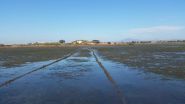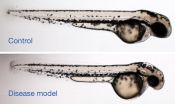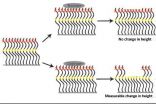(Press-News.org) Twenty years ago, biologists Kathy Boyer and Joy Zedler, then researchers at San Diego State University, speculated that too many insects feeding on cordgrass in the marshes of San Diego Bay could endanger the grass, and in turn endanger the bay wildlife that relies on it.
Picking up where Boyer and Zedler left off, SDSU biologist Jeremy Long is currently further exploring the dimensions of this relationship. What he's found so far suggests that it's not a simple as saying too many insects spell death for a host plant. Instead, his research suggests a complex interplay between insects, plant growth, and the overall stress of the marsh environment.
Knowing more about how these organisms interact could help conservationists protect endangered species, lead to healthier manmade marsh environments, and give ecologists a glimpse into what climate change could mean for the marsh's future.
Urban nature
Sweetwater Marsh, toward the southern end of San Diego Bay, is a study in the dualism of an urban nature preserve. Towering tankers block the horizon behind a vast field of cordgrass and pickleweed. Egrets and herons soar overhead, as do airplanes and helicopters. A five-minute drive will put you in downtown San Diego, but a five-minute walk toward the bay will put you ankle-deep in tidal sludge, filled with snails, sponges, and sea squirts.
A number of endangered plants and animals call this salt marsh home. One of them is the light-footed clapper rail, a cinnamon-and-gray, long-legged wading bird that lives only in Southern California and the northern Baja Peninsula. This bird makes its nest in the marsh's shallow slush, forming its home with strands of the California cordgrass, Spartina foliosa. The nests float and bob with the rising and lowering of the tides.
Another marsh creature relies on the same cordgrass: Haliaspis spartinae, otherwise known as scale insects. These pinhead-sized insects form white, protective armor that allows them to live and feed for their entire lives on a single blade of cordgrass.
Funded by a grant from California Sea Grant, Long set out to discover exactly how these scale insects affect the growth of cordgrass.
Concentrating on cordgrass
For his study, Long and Laura Porturas, then an undergraduate research assistant at SDSU, conducted three experiments on the marsh. First, they visited the marsh once a week and used toothbrushes to remove scale insects from cordgrass in a particular cropping. They let the scale insects go about their usual business on another set of plants. After 20 weeks, they compared the normally-infested plants with the brushed-off ones.
"We saw major negative effects from the scale insects," Long said.
Plants with scale insects were shorter, weighed less, and died off earlier in the season than did the brushed-off cordgrass. This makes sense, Long said, as scale insects sap the cordgrass of sugars and nutrients.
But he was curious whether another factor might also be at play: soil salinity. Saltiness is a constantly churning variable in a salt marsh, and plants like cordgrass have to expend energy filtering and excreting the salt.
So he performed a second experiment in the lab, growing the cordgrass with and without scale insects in either fresh water or seawater. To his surprise, the freshwater cordgrass actually grew taller when it was infested with scale insects than when it wasn't.
Long was initially puzzled. Why did these insects appear to help the cordgrass grow in fresh water but not in salt water? Then he had an idea.
Compensating for consumption
"There's an idea in plant biology called the 'compensatory continuum hypothesis' whereby plants can compensate for grazing by growing more, but this ability changes with environmental stress," Long said.
As for why the cordgrass seemed to overcompensate in fresh water but not in seawater, Long thought that perhaps the effort required to filter the seawater was just too much for the cordgrass, stressing it too much to overcompensate. In the absence of this stress, overcompensation kicked in.
"We hypothesized that when these plants aren't stressed, they can compensate for their grazing [by scale insects] by growing more," Long said.
To test this, Long conducted a third experiment. Back in the salt marsh, he raised the salinity of select locations of cordgrass by adding locally sourced salt, then repeated his toothbrush experiment in these locations, brushing off the insects from some plants but not from others.
He found that once the salinity got high enough, it negated the positive effects of removing the scale insects. In other words, once the water gets too salty, it doesn't matter whether there's an insect infestation or not; the plant grows the same either way.
Salt of the earth
Putting the results from all three experiments together, Long concluded that salinity is a key factor in whether scale insects positively or negatively affect the growth of cordgrass. Long and Porturas published their findings this week in PLOS ONE.
"These plants are always trying to deal with infestation by overcompensating and growing more," he said. "But when the plant gets too stressed by the salt, it doesn't care about the insects anymore."
That's important information for ecologists and wildlife officials who manage the marsh, as well as for future efforts to build manmade salt marshes. Also, as climate change raises the sea level, the marsh might see its natural salinity level increase.
The health of cordgrass is important to more than just clapper rails, Long emphasized. It's a critical environmental element for all of us.
"This plant provides a bunch of functions," he said. "It helps to capture carbon dioxide. It prevents erosion. It serves a buffer for river flow into the ocean. It's really the engineer of its ecosystem."
INFORMATION:
About San Diego State University
San Diego State University is a major public research institution offering bachelor's degrees in 91 areas, master's degrees in 78 areas and doctorates in 22 areas. The university provides transformative experiences, both inside and outside of the classroom, for its 35,000 students. Students participate in research, international experiences, sustainability and entrepreneurship initiatives, and a broad range of student life and leadership opportunities. The university's rich campus life features opportunities for students to participate in, and engage with, the creative and performing arts, a Division I athletics program and the vibrant cultural life of the San Diego region. For more information, visit http://www.sdsu.edu. END
Taking infestation with a grain of salt
New research shows that salinity plays a major role in salt marsh grass's response to insect grazing
2014-10-14
ELSE PRESS RELEASES FROM THIS DATE:
Fermented milk made by Lactococcus lactis H61 improves skin of healthy young women
2014-10-14
Philadelphia, PA, October 13, 2014 – There has been much interest in the potential for using probiotic bacteria for treating skin diseases and other disorders. Japanese researchers have now found that milk that has been fermented using a probiotic dairy starter can also benefit the skin of young healthy women, reports the Journal of Dairy Science®.
Probiotics have been defined by the Food and Agriculture Organization-World Health Organization as "live microorganisms which, when administered in adequate amounts, confer a health benefit to the host."
"Although ...
Study reveals how deadly MERS virus enters human cells
2014-10-14
ITHACA, N.Y. – Cornell University researchers have uncovered details of how the deadly Middle East respiratory syndrome coronavirus (MERS-CoV) enters host cells, and offer possible new avenues for treatment.
The study, appearing online this month in the Proceedings of the National Academy of Sciences, discovered that a common protease enzyme known as furin activates the MERS-CoV to fuse with cell membranes and enter host cells.
The researchers, Gary Whittaker, Cornell professor of virology, and Jean Millet, a postdoctoral associate in Whittaker's lab, suggest ...
Turtle tumors linked to excessive nitrogen from land-based pollution
2014-10-14
Hawai'i's sea turtles are afflicted with chronic and often lethal tumors caused by consuming non-native algae "superweeds" along coastlines where nutrient pollution is unchecked. The disease that causes these tumors is considered the leading cause of death in endangered green sea turtles. The new research was just published in the scientific journal PeerJ.
Turtles that graze on blooms of invasive seaweeds end up with a diet that is rich in a particular amino acid, arginine, which promotes the virus that creates the tumors. Scientists at the University of Hawai'i at Mānoa ...
QUT study helps outdoor workers reduce their skin cancer risk
2014-10-14
Skin cancer is one of the biggest fears for one in two outdoor workers and when the boss and staff work together the sun safe message gets through, a QUT study has found.
The study, which found more than 50 per cent of outdoor workers rated UV radiation exposure at work as one of their biggest concerns, also identified how a workplace intervention could improve workers' behaviours and attitudes towards sun protection to reduce their risk of skin cancer.
QUT in collaboration with Cancer Council Queensland and Curtin University worked with 14 Queensland outdoor workplaces ...
Mediterranean diet, olive oil and nuts can help reverse metabolic syndrome
2014-10-14
For people with metabolic syndrome, a Mediterranean diet supplemented with extra-virgin olive oil or nuts may help reverse the condition, indicate findings from a clinical trial published in CMAJ (Canadian Medical Association Journal).
About 25% of adults around the world have metabolic syndrome. The syndrome exists in the presence of three or more factors such as large waist circumference, high blood pressure, low HDL-cholesterol, high levels of triglycerides and high blood sugar concentrations that can increase the risk of diabetes, heart disease and death.
Spanish ...
For one family, zebrafish help provide genetic answers
2014-10-14
Research in zebrafish has helped identify the cause of an unknown genetic disorder affecting a boy and two of his uncles, scientists report in an article published October 14 in the journal Genetics.
The findings demonstrate the growing importance of zebrafish as laboratory models of rare diseases. Such models allow geneticists to make sense of the deluge of candidate disease genes being uncovered by advances in sequencing technologies. Although rare diseases are uncommon individually, together they affect as many as 25 million people in the United States.
The project ...
Side effects of cancer prevention surgery can be helped with education program
2014-10-14
BOSTON –– More women are having ovary-removing surgery as a cancer prevention measure, but many are often unaware of sexual or psychological side effects of the procedure. A new study by researchers at Dana-Farber Cancer Institute shows a half-day educational program can help successfully deal with these issues by educating women on how to address them.
The program taught women how to manage some of the physical and emotional difficulties that can follow ovary-removing surgery and helped many participants resume satisfying sexual activity and reduce feelings ...
Scientists create new protein-based material with some nerve
2014-10-14
Berkeley — Scientists at the University of California, Berkeley, have taken proteins from nerve cells and used them to create a "smart" material that is extremely sensitive to its environment. This marriage of materials science and biology could give birth to a flexible, sensitive coating that is easy and cheap to manufacture in large quantities.
The work, to be published Tuesday, Oct. 14, in the journal Nature Communications, could lead to new types of biological sensors, flow valves and controlled drug release systems, the researchers said. Biomedical applications ...
Feeling guilty or ashamed? Think about your emotions before you shop
2014-10-14
Suppose you grabbed a few cookies before heading out to the grocery store and start to feel guilty or ashamed about breaking your diet. According to a new study in the Journal of Consumer Research, feeling guilty might find you comparing calories in different cartons of ice cream. Feeling ashamed might keep you from buying any ice cream in the first place.
"We examined the emotions of guilt and shame and found that when consumers feel guilty, they tend to focus on concrete details at the expense of the bigger picture. On the other hand, when consumers feel ashamed, they ...
Marketing an innovative new product? An exciting product launch could hurt sales
2014-10-14
Should every successful product launch involve some sort of dazzling spectacle? A new study in the Journal of Consumer Research tells us that this might be a great way to market an upgrade, but a flashy launch could backfire if a new product is truly innovative.
"The accepted wisdom is that consumers get excited about new and unique products they cannot immediately understand. However, these feelings of excitement can quickly change to tension and anxiety if we can't ultimately make sense of what a product does, especially if we are in a stimulating retail environment," ...
LAST 30 PRESS RELEASES:
How talking slows eye movements behind the wheel
The Ceramic Society of Japan’s Oxoate Ceramics Research Association launches new international book project
Heart-brain connection: international study reveals the role of the vagus nerve in keeping the heart young
Researchers identify Rb1 as a predictive biomarker for a new therapeutic strategy in some breast cancers
Survey reveals ethical gaps slowing AI adoption in pediatric surgery
Stimulant ADHD medications work differently than thought
AI overestimates how smart people are, according to HSE economists
HSE researchers create genome-wide map of quadruplexes
Scientists boost cell "powerhouses" to burn more calories
Automatic label checking: The missing step in making reliable medical AI
Low daily alcohol intake linked to 50% heightened mouth cancer risk in India
American Meteorological Society announces Rick Spinrad as 2026 President-Elect
Biomass-based carbon capture spotlighted in newly released global climate webinar recording
Illuminating invisible nano pollutants: advanced bioimaging tracks the full journey of emerging nanoscale contaminants in living systems
How does age affect recovery from spinal cord injury?
Novel AI tool offers prognosis for patients with head and neck cancer
Fathers’ microplastic exposure tied to their children’s metabolic problems
Research validates laboratory model for studying high-grade serous ovarian cancer
SIR 2026 delivers transformative breakthroughs in minimally invasive medicine to improve patient care
Stem Cell Reports most downloaded papers of 2025 highlight the breadth and impact of stem cell research
Oxford-led study estimates NHS spends around 3% of its primary and secondary care budget on the health impacts of heat and cold in England
A researcher’s long quest leads to a smart composite breakthrough
Urban wild bees act as “microbial sensors” of city health.
New study finds where you live affects recovery after a hip fracture
Forecasting the impact of fully automated vehicle adoption on US road traffic injuries
Alcohol-related hospitalizations from 2016 to 2022
Semaglutide and hospitalizations in patients with obesity and established cardiovascular disease
Researchers ‘listen in’ to embryo-mother interactions during implantation using a culture system replicating the womb lining
How changing your diet could help save the world
How to make AI truly scalable and reliable for real-time traffic assignment?
[Press-News.org] Taking infestation with a grain of saltNew research shows that salinity plays a major role in salt marsh grass's response to insect grazing



